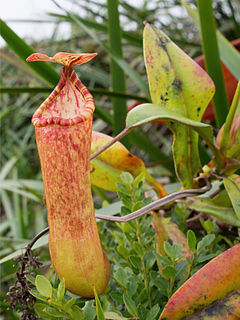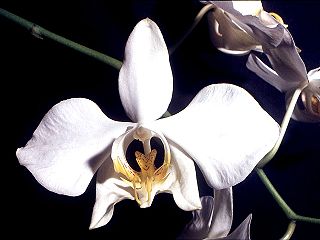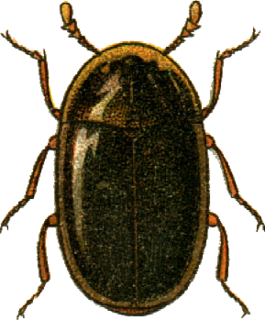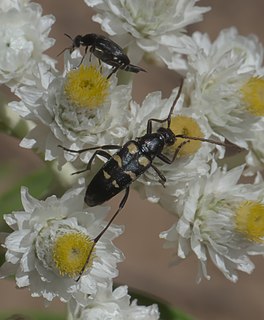
Pseudolarix is a monotypic genus of coniferous trees in the pine family Pinaceae. The sole species, Pseudolarix amabilis, is commonly known as the golden larch, though it is not a true larch (Larix), being more closely related to Keteleeria, Abies and Cedrus. It is native to eastern China, occurring in small areas in the mountains of southern Anhui, Zhejiang, Fujian, Jiangxi, Hunan, Hubei and eastern Sichuan, at altitudes of 100–1,500 m (328–4,921 ft). Golden larch is sometimes known under an old scientific name Pseudolarix kaempferi, but this may cause confusion with Larix kaempferi, the Japanese larch.

The blue-chested hummingbird is a species of hummingbird in the family Trochilidae. It is found in Colombia, Costa Rica, Ecuador, Nicaragua, and Panama. Its natural habitats are subtropical or tropical moist lowland forest and heavily degraded former forest.
Elaphoidella amabilis is a species of copepod in the family Canthocamptidae. Its type locality is Norway.

Nepenthes sumagaya is a tropical pitcher plant native to the Philippines. It is known only from Mount Sumagaya in north-central Mindanao, where it grows in open areas at elevations from 1600 m above sea level to the summit at 2247 m. It is sympatric with N. pantaronensis and possible hybrids between these species have been recorded. Owing to its unusual combination of morphological characters, N. sumagaya has no obvious close relatives in the genus.

Lachesillidae is a family of Psocoptera, or fateful barklice, belonging to the suborder Psocomorpha. Members of the family are characterised by a rounded, free areola postica in their wings. Males have diverse sclerotized genitalic structures. The family includes more than 400 species, most of them in the genus Lachesilla.

Phalaenopsis amabilis, commonly known as the moon orchid or moth orchid in India and as anggrek bulan in Indonesia, is a species of flowering plant in the orchid family Orchidaceae, native to the East Indies and Australia, and widely cultivated as a decorative houseplant. It is an epiphytic or lithophytic herb with long, thick roots, between two and eight thick, fleshy leaves with their bases hiding the stem and nearly flat, white, long-lasting flowers on a branching flowering stem with up to ten flowers on each branch.

Mikadotrochus is a genus of sea snails, marine gastropod mollusks in the family Pleurotomariidae, the slit snails.

Pusia is a genus of sea snails, marine gastropod mollusks in the family Costellariidae.

Kohleria amabilis, the tree gloxinia, is a species of the flowering plant belonging to the family Gesneriaceae.
Sericomyrmex amabilis is a species of ant in the family Formicidae.

Clypastraea is a genus of minute hooded beetles in the family Corylophidae. There are more than 20 described species in Clypastraea.
Acmaeodera amabilis is a species of metallic wood-boring beetle in the family Buprestidae. It is found in North America.

Dendroleon is a genus of antlions in the family Myrmeleontidae. There are more than 20 described species in Dendroleon.

Mycetina is a genus of handsome fungus beetles in the family Endomychidae. There are about 11 described species in Mycetina.

Diomus amabilis, the amiable lady, is a species of lady beetle in the family Coccinellidae. It is found in North America.

Stenostrophia amabilis is a species of flower longhorn in the beetle family Cerambycidae. It is found in North America.
Heterlimnius is a genus of riffle beetles in the family Elmidae. There are about 16 described species in Heterlimnius.
Hippeutister is a genus of clown beetles in the family Histeridae. There are about six described species in Hippeutister.

Holoparamecus is a genus of handsome fungus beetles in the family Endomychidae. There are about 17 described species in Holoparamecus.
Anomopsocus is a genus of fateful barklice in the family Lachesillidae. There are at least two described species in Anomopsocus.













